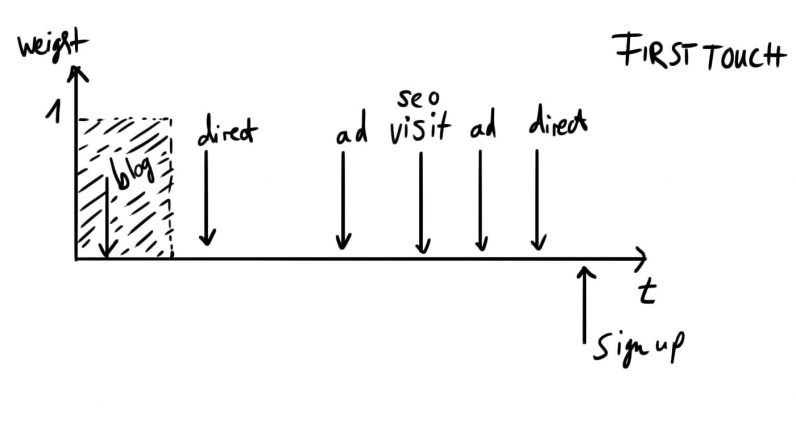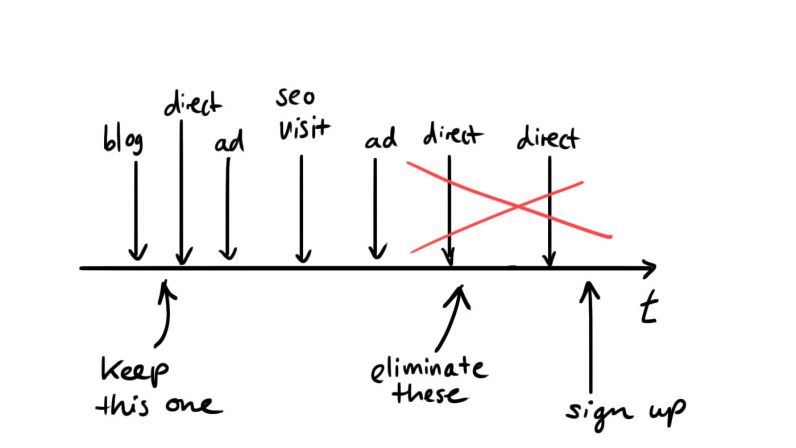#A brief guide to marketing data attribution models

Table of Contents
“#A brief guide to marketing data attribution models”
Attribution is a way for us to see how much each of our activities — across marketing, product, support, and more — is influencing the customer journey. It gives us a holistic view of how each touchpoint — from a blog post to an email to the product itself — contributes to user behavior.
To say attribution models are complex and nuanced would be an understatement: it took us years to build and execute a robust attribution model at Zapier.
But by understanding the more common attribution methods available to you, you can figure out how to use your data to help your company grow.
Types of attribution methods
I’m going to focus on three attribution methods here: first-touch, last-touch, and linear. There are plenty of others to choose from, but these are a great place to start.
First-touch attribution
First-touch attribution means that all the credit for a conversion (e.g., signup, purchase, whatever your business uses) goes to the first way the customer ever interacted with your brand. Did they first land on a blog post on your website? Did they click on a paid ad? Did they find your homepage from search?
Of course, this is a customer’s first trackable exposure to your brand. (If you find a way to automatically track that one time you told your uncle Carl about something, please let me know.)
In the image below, we’re looking at the journey of a customer who interacted with Zapier six times before signing up:
(1) They landed on a blog post, (2) then they visited the site directly by typing in the URL, (3) then they clicked on an ad, (4) then they found a landing page on our site from Google, (5) then they clicked on another ad, (6) and then they visited the site directly again.
It was during that last interaction (visiting the site directly) that they signed up.

When looking at it through the lens of first-touch attribution, even though the customer had a bunch of interactions before signing up (and even if that all happened over the course of a week or a month or a year), the initial blog visit still gets all the credit.
When to use first-touch attribution
First-touch attribution will tell you how someone learned about your brand. That means it’s great at telling you how well your top-of-funnel campaigns and efforts are doing. So, for example, if your blog is bringing in most of your converting traffic, you might put more resources into it.
But because it fails to account for everything after that first touch, it usually makes the most sense when there are shorter sales cycles (or conversion cycles).
Last-touch attribution
Last-touch attribution does the opposite: it gives all the credit to the customer’s last interaction before the conversion event. So using the same example, the direct visit right before they signed up now gets all the credit for the customer’s conversion — regardless of everything else they did before it.

One thing to keep in mind about last-touch attribution: it’s possible you’re going to get a lot of direct visits as your last touch. Direct visits are ones that don’t have a clear source outside of your website. It happens by a user either typing in the URL, clicking a bookmark they saved, or clicking another link that passes no source information along with it.
Now, our marketing and product teams spend a lot of time thinking about engagement: how best to get new visitors interested in re-visiting our pages. If we’re successful in engaging those users, they keep coming back to Zapier, sometimes coming directly on their own (e.g., typing zapier.com into the address bar), no longer needing our help.
That’s a good thing. But when we focus on analyzing that engagement, we want to spend time looking at the user journey before they made a habit of coming back on their own — that is, before their journey began to have lots of direct touches.
To enable this kind of analysis, we look at our attribution data without the last direct touches. This means eliminating all the events after the last non-direct visit.

That helps us focus on what it was that got people to want to come back to our site on their own. In the example above, the last-touch credit would now be given to an ad.
When to use last-touch attribution
Last-touch attribution is best used for mid-funnel or bottom-funnel campaigns — spots where you expect someone to convert from.
You can also default to last-touch attribution if you’re not sure what else to use. It’s the most common attribution method, and it’s simple: a person clicked this ad and signed up. Easy.
Just keep in mind that it will underrepresent top-of-funnel campaigns.
Linear attribution
So we’ve given credit to the first interaction and the last interaction, but what about everything in between?
That’s where linear attribution (a form of multi-touch attribution) comes in. Linear attribution is built on the assumption that every interaction is equally important leading up to a conversion event (and therefore gets the same weight).
In other words, every interaction contributes 1/number_of_interactions to the conversion.

Instead of just knowing the first thing users saw on your website (first-touch), or the last thing they did before converting (last-touch), you can now see multiple touches in one thread.
Using the same example, we now give each of the six interactions equal weight (each one gets one-sixth, or 17%, of the credit). That means the blog gets 17% credit, ads get 34% (because the user saw two ads), and so on.
But that’s an oversimplification and misapplication of multi-touch attribution. The goal isn’t to give out credit — instead, it should be used to deepen your understanding of how customer journeys lead to business outcomes.
That’s why, even though linear attribution might seem more “fair,” it’s by no means a panacea for all attribution questions. It definitely yields some of the most understandable and interpretable outcomes of all various possible multi-touch models, but it’s still a relatively simplistic assumption powering the attribution logic (it’s unlikely that every interaction held the same weight for the user).
As they say, all models are wrong, but some are useful.
When to use linear attribution
Linear attribution builds a much fuller picture of how various efforts contribute to conversions: for marketing attribution, it’s the most robust in determining the effectiveness of your full marketing mix.
But the trade-off is that it weights all touchpoints equally: an ad that a user clicked a month ago will be given just as much weight as the email that the same user opened the morning they signed up. If that’s not nuanced enough for you, there are other models that give different weights to different touchpoints depending on their position in the user journey.
I won’t get into those here, but this article on multi-touch attribution is a great place to start if you want to know more.
At Zapier, we are always trying to do what’s best for our customers. That means that different teams will use different data models to be sure they’re using what’s most relevant for the question they’re looking to answer.
If you have strong building blocks of data and flexible modeling, you’ll be able to do the same.
This article by Lukas Toma was originally published on the Zapier blog and is republished here with permission. You can read the original article here.
If you liked the article, do not forget to share it with your friends. Follow us on Google News too, click on the star and choose us from your favorites.
For forums sites go to Forum.BuradaBiliyorum.Com
If you want to read more like this article, you can visit our Technology category.




